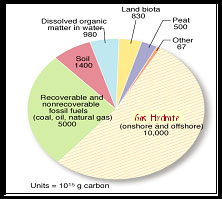

Methane from the oceans could power the world
GLOBE-Net
September 6, 2007
The Economist Magazine recently reported on the effort that is quietly going into the pursuit of what is probably the world's greatest store of fossil fuel - caches of methane, the primary component of natural gas, stored in structures called methane hydrates found in cold Arctic regions and in the marine sediment near continental shelves. Looking just like ice, clathrates (a general term for gas molecules trapped by water molecules) are methane molecules trapped within tiny cages of water molecules. They form where temperatures are low and pressures are high, which is to say, on the sea-floor at the continental shelves, and within the permafrost at the Earth's poles.

Gas hydrates are formed at low temperature and high pressure when sufficient amounts of water and gases such as carbon dioxide or methane are present. This methane has its origins in ancient sea-floor bacteria, which fed on plant and animal remains. As the sediments subsided, the pressure increased and the methane and water froze to form gas hydrates. Gas hydrates are found wherever water gas and water are present at moderately low temperatures and moderately high pressure. As with all fossil-fuel resources, it is hard to estimate just how much methane is trapped in clathrates worldwide.
Numerous deposits have been identified off the coasts of all of the continents and a few of the lakes in Central Asia are just frosty enough to support clathrate formation. Many energy experts agree that clathrate methane reserves could equal twice the rest of the world's fossil fuel supplies combined.
Several countries see gas hydrates as a potential source of energy, because if the methane can be economically produced from these hydrate deposits, the world's natural gas energy supply could be extended for many years to come.
The vast deposits of methane hydrates found in deeper oceanic areas offer considerable hope for future economical recovery and production.
A key driver of the interest in exploiting these potential sources of energy stems from rising energy prices as oil shortages and rising demand increase the costs of conventional energy supplies.
As well, an increasing proportion of the world's oil supplies are being sourced from politically unstable areas. Security of energy supplies for many countries is driving new investments in biomass technologies.
The technological challenges are daunting as are the risks. Soil instability induced by offshore drilling and production operations represent a potential geohazard adjacent to offshore structures, where hydrate occurrence may result in foundation problems. Such vast unstable deposits are prone to underwater landslides, such as a landslide estimated to have taken place 8000 years ago in the North Sea that created a tsunami that flooded much of coastal Scotland and Norway.
As well, methane hydrate deposits in the ocean and tundra regions contain three times more methane than what occurs naturally in the atmosphere. "Methane is the cleanest of the fossil fuels when burned; but released directly into the atmosphere, it is a 'greenhouse gas' significantly more potent than carbon dioxide," notes The Economist.
Methane is a powerful greenhouse gas with a greenhouse warming potential (GWP) 23 times that of CO2 on a per-molecule basis. The sudden release of methane from gas hydrate therefore has the potential to affect global climate.
When the sea level dropped during the last ice age, the destabilization of hydrate and the release of methane may have been sufficient to heat the atmosphere via greenhouse effects and turn back the ice age.
As well, many clathrate deposits sit atop large reservoirs of free gas. Drilling into the clathrate deposits could unleash an enormous 'methane burp' of size, with devastating environmental impacts.
However, if gas hydrates can be harnessed as an energy source, the increased use of clean-burning methane (in relation to sulfurous coal, for example) would contribute to reductions in greenhouse gas emissions worldwide.
The strong potential of gas hydrates has motivated national research programs in the United States, Canada, Japan, Korea, and India to investigate methods to quantify the amount of hydrate present in the subsurface through geological and geophysical remote sensing methods.
While Canada and India have invested heavily in hydrate research, the largest effort has been in Japan. Japan imports roughly most of its fossil fuels, and would like to find a domestic energy resource.
As noted by The Economist, a Japanese collaboration has drilled about 30 wells, with a timeline to start production and distribution of methane from hydrates by 2016. In June, China reported having pulled up some first methane-bearing samples from the South China Sea. A US-based consortium of government agencies and petroleum companies has been drilling for clathrates in the Gulf of Mexico with some success.
In Canada, an international consortium including Canada, United States, Japan and Germany has been formed to establish a world research site for the study of continental natural gas hydrates in the Mackenzie Delta of northwestern Canadian Arctic. This site, the Mallik gas hydrate field, was discovered through an exploration well drilled by Imperial Oil Ltd. in 1971-1972.
Scientists acknowledge that methane hydrate commercialization is 20 to 30 years away. Given that the lion's share of known methane hydrate deposits is found in the Pacific Ocean and neighbouring permafrost environments, it is a subject of great interest to Canada in general and British Columbia in particular.
The bottom line is that these methane deposits represent a huge potential source of new hydrocarbon energy - one that cannot be ignored.
An excellent Backgrounder on Methane Gas Hydrates is a report prepared by Kenneth White of Acton White Associates Inc. This report is available exclusively from GLOBE-Net.
http://www.globe-net.ca/news/index.cfm?type=2&newsID=3097
Details on the Mallik project are available here
http://gsc.nrcan.gc.ca/gashydrates/mallik2002/index_e.php
Source: GLOBE-Net www.globe-net.ca